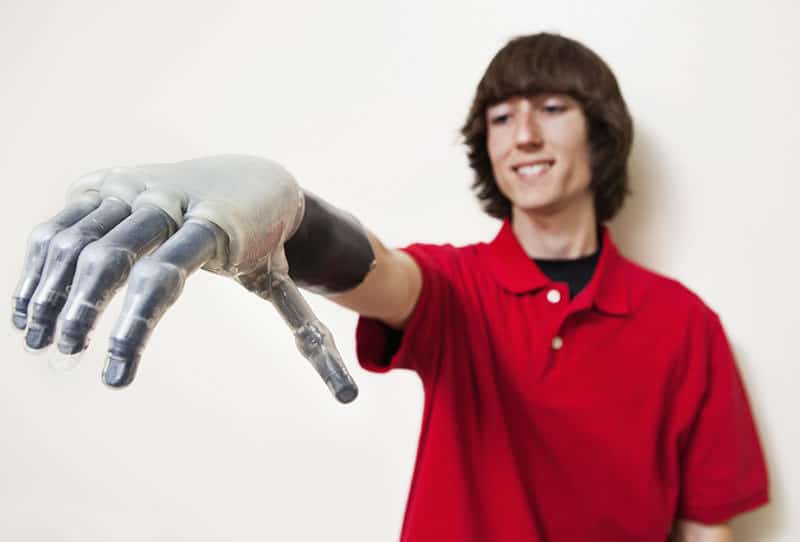The first prosthetic limb that was used by a human was a toe. This toe was found attached to a woman’s body in Egypt, and it dates back to the years of 950-750, B.C..
Since then, technology has developed significantly. Johns Hopkins University has worked to develop a prosthetic limb that allows individuals to control prosthetic limbs with their minds. People are able to operate the limbs because the prosthetic limbs connect to nerve endings.
The cost to develop each of these limbs is about $500,000. While the researchers’ ultimate goal is to reduce the cost of production, prosthetic limbs are currently a very costly items.
So, imagine if a prosthetic limb is damaged in an accident. Who is going to pay for it? And how can they possibly afford it.
Currently, the law treats damage to a prosthetic limb as property damage. The law makes a distinction between the individual and the prosthetic. Proponents of this approach point out that prosthetic limbs do not contain DNA. Rather, these limbs are made of plastic or metal. They argue that the limbs are manmade and are much different from biological limbs with which humans are born.
Many believe that personal injury law may need to expand in order to include damage to prosthetic limbs; or to consider them personal injury as opposed to property damage. As technology develops, new questions emerge. Often these questions will be solved in courtrooms. Courts may have to reconsider whether damage to prosthetic limbs should still be labeled as property damage or if personal injury law needs to expand to cover damage to prosthetic limbs.
Why Do Some People Believe that the Law Should Treat Damage to Prosthetic Limbs as a Personal Injury?
The main reason why there has been a push to treat damage to prosthetic limbs as property damage is the expansion of technology in this field. Proponents of categorizing damage to prosthetic limbs as a personal injury believe that new developments in technology show that prosthetic limbs are not merely property. Rather, these limbs become an integral part of an individual’s body.
Just like almost every other technology, prosthetic limbs have become increasingly more modern since they were first developed. Johns Hopkins University’s research that was discussed in the introduction illustrates the modernization that is occurring in prosthetic limbs.
This technology clearly demonstrates the difficulty in categorizing damage to prosthetic limbs. This new technology has blurred the lines between the human body and the prosthetic limbs because the limbs can communicate directly to the body through the use of electrical signals, and because of this communication the prosthetic limb is able to operate in a nearly identical manner as a biological limb operates.
Since the prosthetic limb is able to operate in the same manner that a biological limb would operate, people argue that the prosthetic limb is just an extension of an individual’s body. In fact, many people that depend on the use of prosthetic limbs do not make a distinction between the prosthetic limb and their body. They often consider the prosthetic limb to be part of them, and sometimes these limbs often become a permanent part of an individual’s body. Some prosthetic limbs are fused to the patient’s bone marrow. After this operation, the limb cannot be removed without another operation. This is a huge change from detachable limbs , and thus, the argument is made that prosthetic limbs are not just property.
Another reason why there is a push to categorize damage to prosthetic limbs as a personal injury is that people form a psychological connection to their prosthetic limb that mirrors the connection that an individual would display to their biological limb.
Prosthetic limbs have always had a psychological impact on people. Historians believe that the prosthetic toe that was discovered on the Egyptian woman was created so that the woman could continue to wear sandals. The Egyptian sandal was a very important part of society and the woman likely possessed the prosthetic toe so that she could fit into this tradition.
Today, the use of the prosthetic limb often brings a sense of identity to an amputee that once felt incomplete.
How Would Categorization of Damage to a Prosthetic Limb Impact Personal Injury Cases?
Two big things would change if damage to prosthetic limbs is considered a personal injury rather than property damage. First, the recovery that people who suffer damage to a prosthetic limb would likely increase.
Currently, the law treats damage to prosthetic limbs just like any other type of property damage. This concept can be illustrated through an example. If an individual’s prosthetic limbs were destroyed after a car accident, current law would treat damage to the prosthetic limb just like damage to a car.
This likely means that the victim would be able to recover the cost of the limb. Proponents of changing the law to consider damage to a prosthetic as a personal injury believe that the damages that individuals receive under the property damage regime do not adequately demonstrate the victim’s reliance on the prosthetic limb. This is because monetary policy limits on property damage are often much lower than personal injury policy limits. For more information on policy limits, read our blog on “How Insurance Works.â€
For example, in 2009, American Airlines damaged a quadriplegic veteran’s mobility assistive device. American Airlines offered to pay the veteran $1,500 to replace the device. This compensation did not reflect the fact that the veteran was completely dependent on the device for mobility. In fact, without the assistance of the mobility assistive device the veteran lost all mobility. Clearly, $1,500 is not enough compensation to reflect the harm that the veteran suffered because of American Airline’s negligence.
In addition, if there was a shift to considering damage to prosthetic limbs personal injury the prosthetic limbs would be protected by laws that cover assault and battery rather than strictly property damage. This will allow people who have prosthetic limbs to utilize more theories of recovery than they can currently use. The expansion of causes of action will also likely increase the recovery that individuals with prosthetic limbs can recover in a lawsuit.














